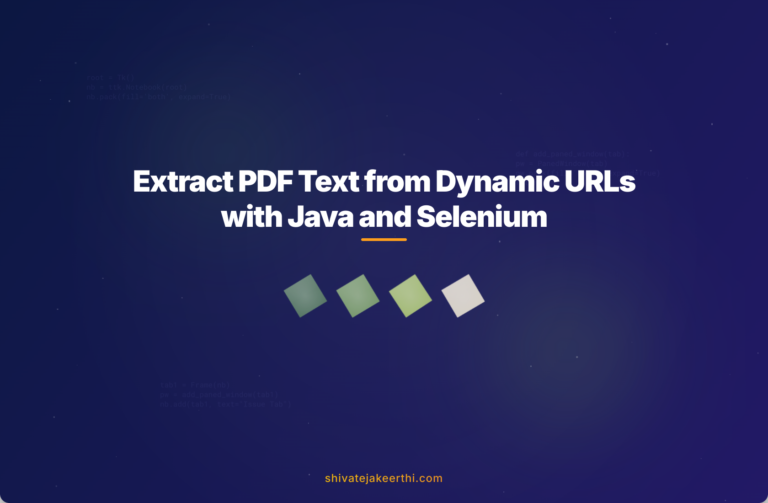Extracting PDF content directly from a dynamic URL without downloading can sometimes feel like chasing a moving target. You’ve probably encountered cases where clicking a button generates a PDF report dynamically, opening it in a new tab or a temporary URL. If your goal is to automate data extraction from PDFs generated in this way using Java, Selenium, and PDFBox, you’ve come to the right place.
Dynamic PDFs generated through JavaScript-based web actions pose specific challenges. Since the PDF content isn’t served from a fixed URL, traditional methods of file downloading and content reading might fail or become inefficient. Fortunately, tools like Selenium for browser automation and PDFBox for PDF parsing provide a powerful combination that’s capable of tackling such scenarios.
Understanding Your Tools: PDFBox and Selenium
Before jumping into the solution, let’s briefly look at the tools.
Apache PDFBox Overview
PDFBox is a popular Java library (PDFBox) designed to read and manipulate PDF documents. It easily extracts text, images, and even metadata from PDFs. Developers love it because it’s lightweight, efficient, and integrates smoothly into Java applications.
For this exercise, we’ll specifically use PDFBox version 2.0.17, which has proven reliable for parsing PDF content directly from URLs and streams.
Selenium Browser Automation
Selenium (official link) is a powerful framework primarily built for automating browser actions. Whether you’re filling forms, clicking buttons, or extracting dynamic web content, Selenium can simulate human interaction seamlessly in most browsers.
We’ll leverage Selenium’s abilities to extract dynamically generated PDF URLs and handle any tab-switching or human-like interactions required.
Requirements for the Task
Let’s outline what you need for this task clearly:
- Java JDK setup on your environment.
- Selenium WebDriver (e.g., ChromeDriver if you’re using Chrome).
- PDFBox 2.0.17 explicitly in your project’s dependencies.
- A stable IDE of your preference (like Eclipse or IntelliJ IDEA).
- Maven or Gradle for managing your Java dependencies (recommended).
Step-by-Step Solution Approach
Let’s outline an effective strategy clearly and practically:
1. Obtaining the PDF URL Using Selenium
First, use Selenium to automate the actions leading to the PDF generation—clicking buttons or interacting with dropdowns—until the browser opens the PDF in a new tab or window. Typically, you capture the URL at this stage using Selenium’s getCurrentUrl() method:
//Perform actions to open the PDF
driver.findElement(By.id("generatePdf")).click();
// Wait until a new tab opens
Thread.sleep(3000); // or use proper wait conditions
// Switch to the new tab
ArrayList<String> tabs = new ArrayList<>(driver.getWindowHandles());
driver.switchTo().window(tabs.get(1));
// Get the current URL of the PDF
String pdfUrl = driver.getCurrentUrl();
2. Switching Properly to the New PDF Tab
When Selenium opens PDFs, they typically open in a new browser tab or window. Selenium treats these tabs separately and requires explicit commands for switching tabs, as shown above.
After you obtain the PDF URL, you’ll need to be sure your Selenium instance has properly switched to the correct tab before proceeding further.
3. Extracting PDF Content Without Download Using PDFBox
After grabbing the PDF’s dynamic URL, use PDFBox to open a connection stream directly. Here’s a clean way to get started:
//Open connection via URL stream directly without downloading file
URL url = new URL(pdfUrl);
InputStream input = url.openStream();
//Load PDF document using PDFBox
PDDocument document = PDDocument.load(input);
//Extract PDF text content
PDFTextStripper pdfStripper = new PDFTextStripper();
String pdfContent = pdfStripper.getText(document);
System.out.println(pdfContent);
//Close Streams
document.close();
input.close();
This approach ensures no local files are created or stored on your system—a major benefit for resource optimization and security.
Error Analysis: Common Problems You May Face
As straightforward as this solution seems, you might face issues like “End-of-File Exception” or other related PDF loading errors. Let’s clarify some potential issues and how to resolve them quickly.
Understanding the Error Message
A common error is:
java.io.IOException: Error: End-of-File expected line
This kind of exception typically indicates incomplete PDFs, incorrect URLs, or issues with reading the streamed content.
Possible reasons include:
- Incompletely generated PDF files (still rendering).
- Authentication requirements or session issues with dynamic URLs.
- Network interruptions causing corrupted PDF streams.
Troubleshooting Steps You Should Take Immediately
- Check URL Accessibility: Ensure PDF URL opens directly in browsers.
- Ensure PDF Generation Completeness: Use Selenium explicit wait conditions to wait fully for the PDF generation.
- Validate Your Stream: Confirm InputStream isn’t prematurely closing or timing out due to server settings.
Handling Dynamic & Temporary URLs
When dealing with session-specific dynamic URLs, Selenium might need your browser’s cookies or session data. Try mimicking browser sessions by copying cookies from Selenium into Java’s URLConnection (advanced but helpful in some cases).
Alternative PDF Libraries & Approaches
If handling PDFs with PDFBox continues to present challenges, don’t hesitate to try other robust libraries:
- iText PDF: A popular but commercially licensed PDF toolkit providing feature-rich PDF parsing.
- Tabula: For table-rich PDFs, extremely good with structured tabular data.
Alternatively, use Selenium’s browser capabilities to read PDF directly through specialized plugins or navigate JavaScript-heavy pages differently. Adjusting your method based on scenarios is perfectly acceptable.
Recap and Recommendations
We’ve covered comprehensively how you can easily extract PDF contents from dynamically-generated URLs without explicitly downloading files using Java tools: Selenium and PDFBox.
Remember to always handle dynamic URLs cautiously, making sure your Selenium automation correctly captures the current active tab and ensuring streams are stable and fully loaded before attempting PDF parsing.
To further enhance your workflow for web dynamic content, you may also enjoy exploring articles on JavaScript automation techniques found in the JavaScript category. Familiarizing yourself with automation at multiple layers often yields smoother overall automation strategies.
Have you run into other interesting challenges Extracting dynamic PDF content through Selenium and Java? Share your experiences or let me know if you need help debugging your current setup!



0 Comments